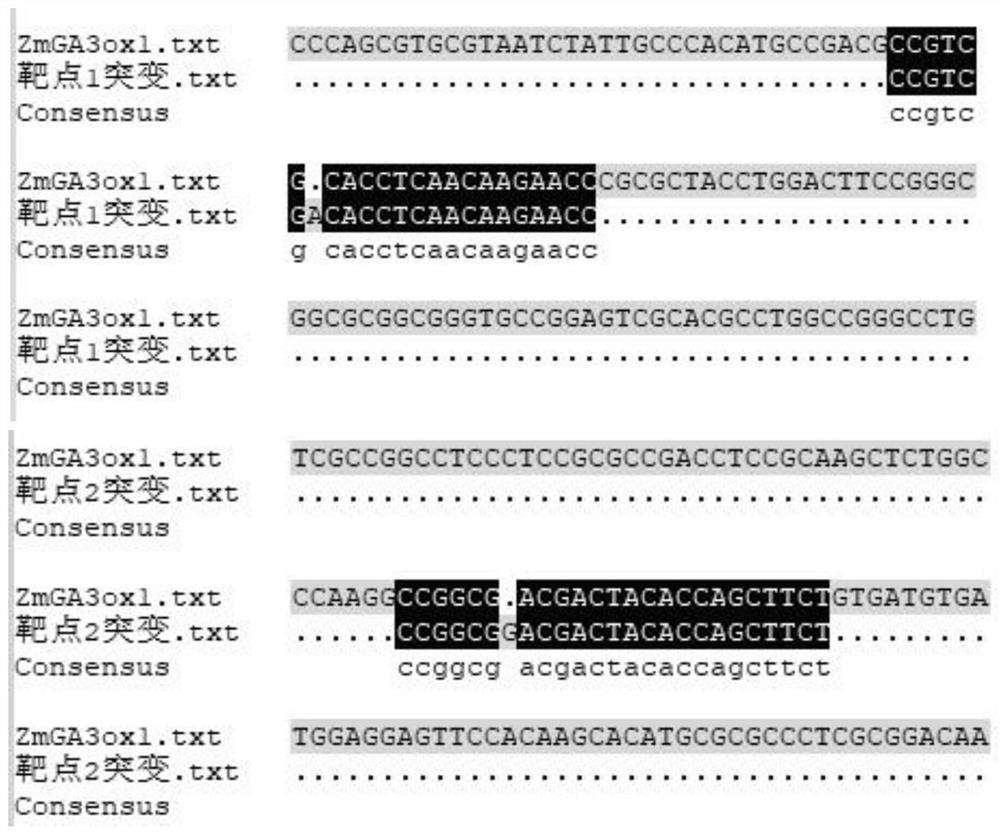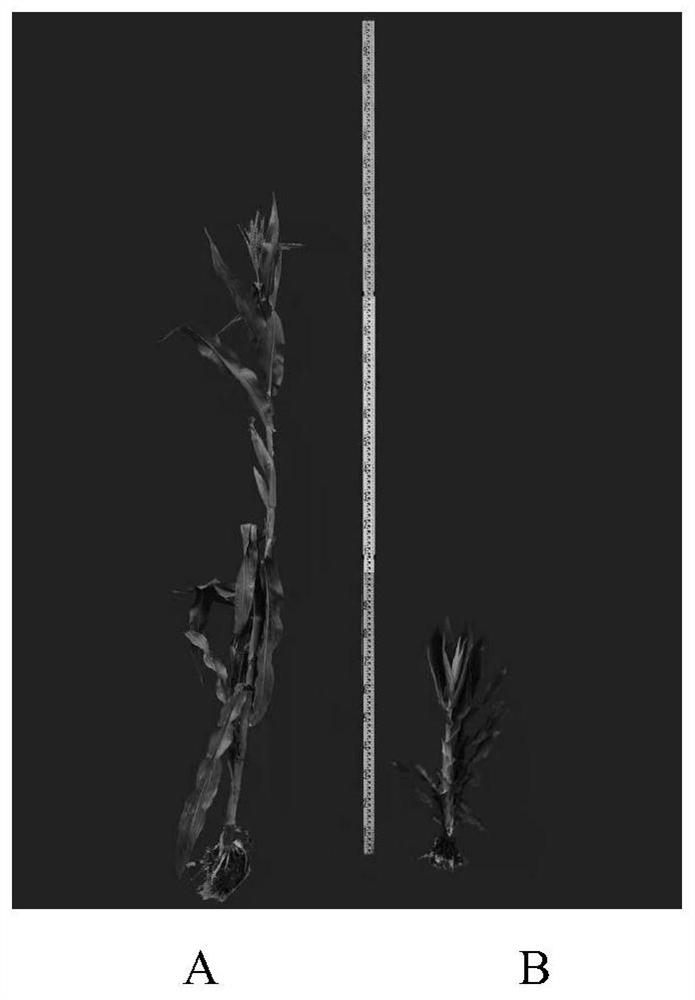A method of using gene editing technology to create corn dwarfing materials
A gene editing and corn technology, applied in the field of genetic engineering, can solve the problems of reducing yield, limiting the application effect of improved materials, and taking a long time to achieve the effect of reducing plant height
- Summary
- Abstract
- Description
- Claims
- Application Information
AI Technical Summary
Problems solved by technology
Method used
Image
Examples
Embodiment 1
[0034] Example 1 Construction of gene editing vector
[0035] (1) The gene that controls the plant height of maize is the ZmGA3ox1 gene, and its nucleotide sequence is as follows:
[0036]ATGCCGACGCCGTCGCACCTCAACAAGAACCCGCGCTACCTGGACTTCCGGGCGGCGCGGCGGGTGCCGGAGTCGCACGCCTGGCCGGGCCTGCACGACCACCCCGTCGTGGACGGCGGCGCGCCGGGCCCCGACGCCGTGCCGGTGGTGGACCTGGGCGCCGCGGACCCGGCGCCGGCGCCGGCGGCGGCGGTGGCCCGCGCCGCCGAGCAATGGGGCGCGTTCCTGCTCACGGGCCACGGCGTCCCCGCGGACCTGCTGGCGCGCGTGGAGGACCGGATCGCCACCATGTTCGCGCTGCCGGCCGACGACAAGATGCGCGCCGTGCGCGGGCCCGGCGACGCCTGCGGCTACGGCTCCCCGCCCATCTCCTCCTTCTTCTCCAAGTGCATGTGGTCCGAGGGCTACACCTTCTCGCCGGCCTCCCTCCGCGCCGACCTCCGCAAGCTCTGGCCCAAGGCCGGCGACGACTACACCAGCTTCTGTGATGTGATGGAGGAGTTCCACAAGCACATGCGCGCCCTCGCGGACAAGCTGCTGGAGCTGTTCCTCATGGCGCTGGGGCTCACCGACGAGCAGGCCAGCGCCGTCGAGGCCGAGCGGAGGATCGCCGAGACGATGACCGCCACCATGCATCTCAACTGGTACCCGAGGTGCCCGGACCCGCGGCGCGCGCTGGGGCTGATCGCGCACACCGACTCGGGCTTCTTCACCTTCGTGATGCAGAGCCTCGTGCCCGGGCTGCAGCTCTTCCGCCACGCCCCGGACCGGTGGGTGGCGGTGCCGGCCGTGCCGGGCGCCTTCG...
Embodiment 2
[0053] Example 2 The gene editing vector was transformed into Agrobacterium LBA4404
[0054] 1) CaCl 2 Preparation of Agrobacterium tumefaciens competent cells
[0055] (1) From the YEP plate (Rif R ,Str R ), pick a fresh single colony of EHA105 and inoculate it in YEP liquid medium containing 50mg / L Str and 25mg / L Rif, 28°C, 220rpm shaking culture overnight for 24-36h;
[0056] (2) Take 2ml of overnight activated bacterial liquid in the logarithmic growth phase, inoculate it in 50mL YEP liquid medium, and cultivate the bacterial liquid OD at 20°C 600 to about 0.4 to 0.6;
[0057] (3) Transfer the bacterial liquid to an ice-precooled 50 mL sterile centrifuge tube, ice bath for 30 min, centrifuge at 4,000×g for 10 min at 4°C, and enrich the bacterial cells;
[0058] (4) Pre-cool 0.05M CaCl with 10mL ice 2 Suspend the bacterial cells, take an ice bath for 30 min, centrifuge at 4,000 × g for 10 min at 4 °C, and enrich the bacterial cells;
[0059] (5) Pre-chill 0.05M CaCl ...
Embodiment 3
[0072] Example 3 Maize genetic transformation
[0073] (1) The material for embryo extraction was the corn inbred line C01. The young maize embryos were observed on the ninth day after pollination. When the embryos grew to about 1.5 mm, the ear was taken back to the laboratory for embryo extraction.
[0074] (2) Prepare the Agrobacterium infection solution, when the activated Agrobacterium is shaken to a specific concentration (OD) in the YEB liquid medium 550 = 0.5), collect the cell pellet by low-speed centrifugation, and then use inf (per liter composition: N6 salt and vitamin (sigma) 2 g, sucrose 68.5 g, glucose 36 g, L-proline 0.7 g, MES 0.5 g, 1 mg / ml 2,4-D 1.5ml)+AS (Acetosyringone, (100mM), 1ml)) liquid medium to resuspend, shake at 75r / min at 25°C for 24h, until the concentration is OD 550 =0.3-0.4.
[0075] (3) The immature embryos taken out in (1) were washed twice with inf+AS (same as above) liquid medium, and then Agrobacterium infection solution was added to infe...
PUM
 Login to View More
Login to View More Abstract
Description
Claims
Application Information
 Login to View More
Login to View More - R&D
- Intellectual Property
- Life Sciences
- Materials
- Tech Scout
- Unparalleled Data Quality
- Higher Quality Content
- 60% Fewer Hallucinations
Browse by: Latest US Patents, China's latest patents, Technical Efficacy Thesaurus, Application Domain, Technology Topic, Popular Technical Reports.
© 2025 PatSnap. All rights reserved.Legal|Privacy policy|Modern Slavery Act Transparency Statement|Sitemap|About US| Contact US: help@patsnap.com


